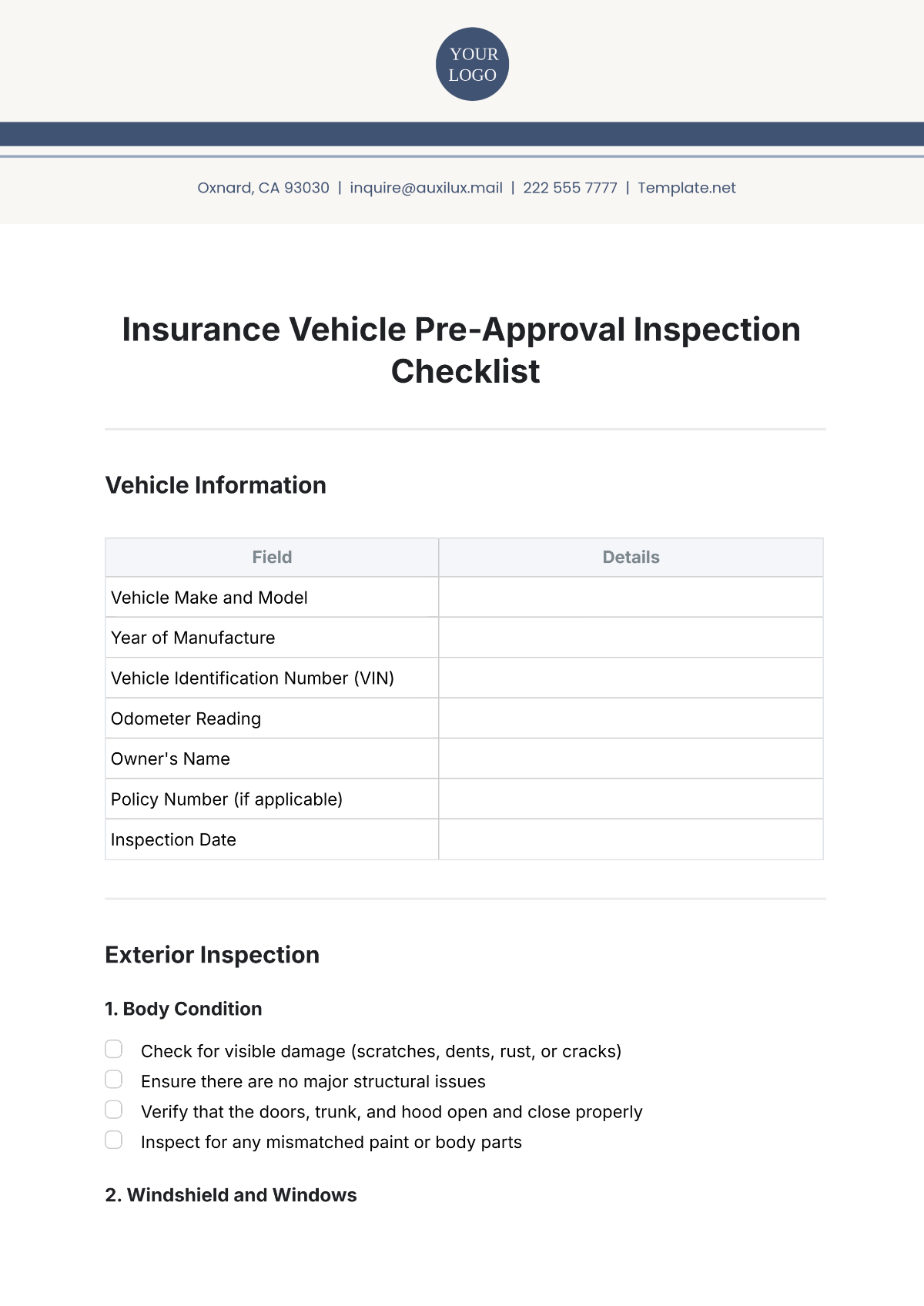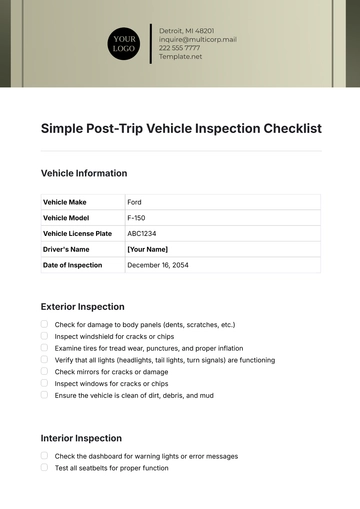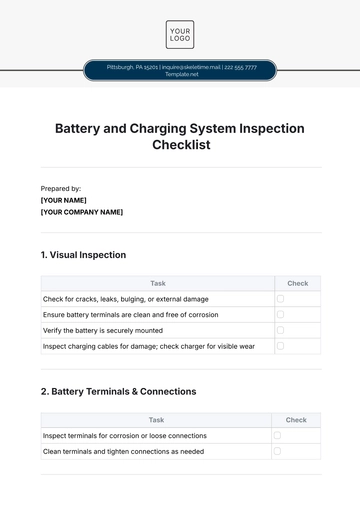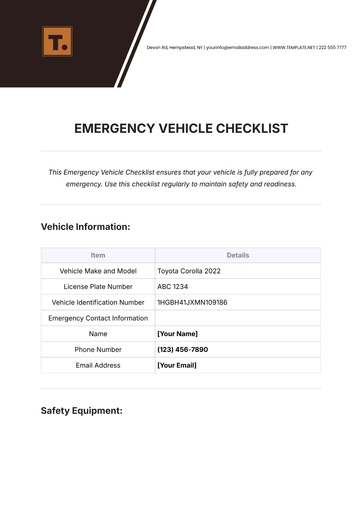Free Insurance Vehicle Pre-Approval Inspection Checklist

Vehicle Information
Field | Details |
|---|---|
Vehicle Make and Model | |
Year of Manufacture | |
Vehicle Identification Number (VIN) | |
Odometer Reading | |
Owner's Name | |
Policy Number (if applicable) | |
Inspection Date |
Exterior Inspection
1. Body Condition
Check for visible damage (scratches, dents, rust, or cracks)
Ensure there are no major structural issues
Verify that the doors, trunk, and hood open and close properly
Inspect for any mismatched paint or body parts
2. Windshield and Windows
Inspect windshield for cracks or chips
Check side and rear windows for cracks, chips, or functionality
Ensure wipers are functional and in good condition
3. Tires
Check tire tread depth and wear
Inspect tires for any visible damage (cuts, bulges, punctures)
Ensure all tires are properly inflated
4. Lights and Indicators
Test headlights (low and high beams)
Check taillights, brake lights, and turn signals
Inspect reverse lights, fog lights, and license plate lights for functionality
5. Mirrors
Inspect side mirrors and rearview mirrors for cracks or damage
Ensure proper adjustability and visibility
Interior Inspection
1. Seats and Upholstery
Inspect for any tears, stains, or excessive wear on seats
Check the adjustability of the seats
Ensure that seat belts are in good condition and functional
2. Dashboard and Controls
Test all dashboard lights (check engine, airbag, etc.)
Ensure that all controls (AC, heat, radio, etc.) are functional
Verify the functionality of airbags and any safety features
3. Safety Features
Confirm presence of airbags (front, side, and curtain if applicable)
Ensure that the seatbelts function properly and are intact
Check child safety locks (if applicable)
Mechanical Inspection
1. Engine and Transmission
Inspect the engine for any visible leaks or irregularities
Check fluid levels (engine oil, coolant, brake fluid, transmission fluid)
Verify that the engine starts smoothly without abnormal noises
Inspect the condition of belts and hoses
2. Brakes
Check the brake pads for wear
Inspect brake discs and drums for signs of damage
Test braking performance (no unusual vibrations or sounds)
3. Suspension
Check for any visible damage to the suspension system
Ensure that shocks and struts are in proper working condition
Inspect the undercarriage for rust or excessive wear
4. Battery
Check the condition of the battery
Inspect the terminals for corrosion or loose connections
Additional Checks
1. VIN and Documentation
Verify the VIN number against the vehicle registration and insurance documents
Ensure that the vehicle's registration and insurance are up to date
2. Inspection for Stolen Vehicle
Cross-check the vehicle with databases to ensure it is not reported stolen
Ensure all parts and accessories match the vehicle’s documentation
3. Emissions and Environmental Compliance
Verify that the vehicle complies with local emissions standards
Check the exhaust system for leaks or damage
Inspection Completed by: [Your Name]
Date:
Inspection Outcome: (Approved / Not Approved)
Remarks/Notes:
- 100% Customizable, free editor
- Access 1 Million+ Templates, photo’s & graphics
- Download or share as a template
- Click and replace photos, graphics, text, backgrounds
- Resize, crop, AI write & more
- Access advanced editor
The Insurance Vehicle Pre-Approval Inspection Checklist Template from Template.net is an editable and customizable tool designed for thorough vehicle assessments. Easily adjust the checklist to fit your needs using our AI Editor Tool. This template ensures accurate inspections, helping insurance companies streamline the pre-approval process and maintain vehicle safety and compliance.
You may also like
- Cleaning Checklist
- Daily Checklist
- Travel Checklist
- Self Care Checklist
- Risk Assessment Checklist
- Onboarding Checklist
- Quality Checklist
- Compliance Checklist
- Audit Checklist
- Registry Checklist
- HR Checklist
- Restaurant Checklist
- Checklist Layout
- Creative Checklist
- Sales Checklist
- Construction Checklist
- Task Checklist
- Professional Checklist
- Hotel Checklist
- Employee Checklist
- Moving Checklist
- Marketing Checklist
- Accounting Checklist
- Camping Checklist
- Packing Checklist
- Real Estate Checklist
- Cleaning Checklist Service
- New Employee Checklist
- Food Checklist
- Home Inspection Checklist
- Advertising Checklist
- Event Checklist
- SEO Checklist
- Assessment Checklist
- Inspection Checklist
- Baby Registry Checklist
- Induction Checklist
- Employee Training Checklist
- Medical Checklist
- Safety Checklist
- Site Checklist
- Job Checklist
- Service Checklist
- Nanny Checklist
- Building Checklist
- Work Checklist
- Office Checklist
- Training Checklist
- Website Checklist
- IT and Software Checklist
- Performance Checklist
- Project Checklist
- Startup Checklist
- Education Checklist
- Home Checklist
- School Checklist
- Maintenance Checklist
- Planning Checklist
- Manager Checklist
- Wedding Checklist
- Vehicle Checklist
- Travel Agency Checklist
- Vehicle Inspection Checklist
- Interior Design Checklist
- Backpacking Checklist
- Business Checklist
- Legal Checklist
- Nursing Home Checklist
- Weekly Checklist
- Recruitment Checklist
- Salon Checklist
- Baby Checklist
- Equipment Checklist
- Trade Show Checklist
- Party Checklist
- Hospital Bag Checklist
- Evaluation Checklist
- Agency Checklist
- First Apartment Checklist
- Hiring Checklist
- Opening Checklist
- Small Business Checklist
- Rental Checklist
- College Dorm Checklist
- New Puppy Checklist
- University Checklist
- Building Maintenance Checklist
- Work From Home Checklist
- Student Checklist
- Application Checklist





























